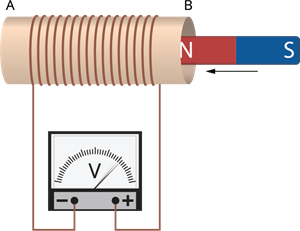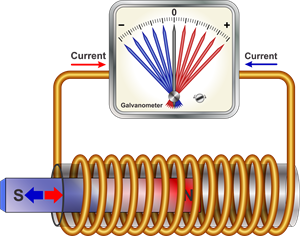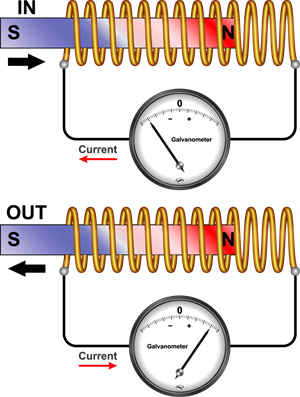PDF chapter test TRY NOW
In the previous sections, we have studied that when a current-carrying conductor is placed in a magnetic field such that the direction of the current is perpendicular to the magnetic field, it experiences a force. This force causes the conductor to move.
Now let us consider a situation in which a conductor moves inside a magnetic field or a magnetic field changes around a fixed conductor.
What will happen?
In \(1831\), English physicist Michael Faraday first studied this; Faraday made a significant breakthrough by discovering how a moving magnet can be used to generate electric currents.
To observe this effect, let us perform the following activity.
Now let us consider a situation in which a conductor moves inside a magnetic field or a magnetic field changes around a fixed conductor.
What will happen?
In \(1831\), English physicist Michael Faraday first studied this; Faraday made a significant breakthrough by discovering how a moving magnet can be used to generate electric currents.
To observe this effect, let us perform the following activity.
- Consider a coil of wire AB having a large number of turns.
- Connect the ends of the coil (AB) to a galvanometer, as shown in the below figure.

Moving magnet in a fixed conductor
- Take a strong bar magnet and move its north pole towards the end B of the coil.
- Do you find any change in the galvanometer needle?
There is a transient deflection in the needle of the galvanometer, say to the right. This deflection shows the presence of a current in the coil AB. The deflection becomes zero the moment the motion of the magnet stops.
- Now withdraw the north pole of the magnet away from the coil.
The galvanometer is deflected toward the left, showing that the current is set up opposite to the earlier deflection.

Moving a magnet towards a coil sets up a current in the coil circuit, as indicated by deflection in the galvanometer needle
- Locate the magnet stationary at a point near the coil, maintaining its north pole towards the end B of the coil.
We can observe that the galvanometer needle deflects toward the right when the coil is moved towards the magnet's north pole. Similarly, the needle moves toward the left when the coil is moved away.
- When the coil is kept stationary with respect to the magnet, the deflection of the galvanometer drops to zero.
What do you conclude from this activity?
You can also check that if you had moved the magnet's south pole towards the end B of the coil, the deflections in the galvanometer would just be opposite to the previous case. When the coil and the magnet are both stationary, there is no deflection in the galvanometer.

Moving a magnet towards and away to a coil
It is, thus, clear from this activity that the motion of a magnet with respect to the coil produces an induced potential difference, which sets up an induced electric current in the circuit.
Summary:
The below table shows the relationship between the position of a magnet and the deflection in the galvanometer.
Position of a magnet | Deflection in galvanometer |
Rest | No deflection |
Moves towards the coil | Deflection in galvanometer in one direction |
Kept stationary at the same position (near the coil) | No deflection in the galvanometer |
Moves away from the coil | Deflection in galvanometer but in the opposite direction |
Kept stationary at the same position (away from the coil) | No deflection in the galvanometer |
